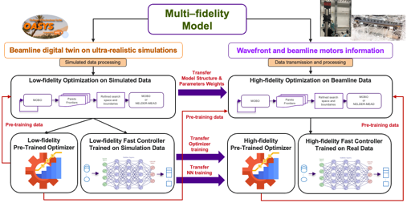| Optical Simulations |
Beamline optics simulation is essential for the new beamline development as well as for improving the beamline operation. The group specialists widely use the optics simulation suite OASYS to provide simulation support and develop integrated advanced optics simulation methods.
|
| The HYBRID method simulates diffraction effects from apertures, mirror clipping, and figure or thickness errors in optics. Integrated into OASYS as a ShadowOui widget, it features an automated user interface. |
We added new widgets extending the looping mechanism embedded in OASYS, to provide accurate calculations of the specifications of mirrors, not only in terms of shape and dimension, but also critical technical details like (i) the resolution of motors to activate translations and rotations (ii) the manufacturing quality of mirrors in term of height (surface) errors.
|
| A new set of widgets has been developed and added to OASYS to create an iterative ab initio procedure to compute the thermal load in every critical element of the beamlines. The new tool integrates SRW for the source radiation simulation, ShadowOui for the beam propagation through beamline elements, and other tools for providing material and optical properties. |
We modeled focusing bendable elliptical mirrors as realistic as possible by integrating into the simulation the real surface generated by a dynamical bending device, activated by one or two (unequal) end couples, and considering that the shape of the mirror can be trapezoidal. The surface profile generated by a bender can be calculated analytically. The implemented ShadowOui widget uses the non-linear least-square fit of the bent mirror profile to approach the ideal surface profile for a given focal condition.
We also integrated into OASYS the wave optics simulations currently used by the Optics group to manufacture nanofocusing Zone Plates. A dedicated ShadowOui widget provides, by using the Hybrid method, accurate and realistic raytracing simulations. [L. Rebuffi, et al., J. Synchrotron Rad. 27(5), 1108–1120 (2020), DOI: 10.1107/S160057752000778X; L. Rebuffi & X. Shi, Proc. SPIE 11493, 1149303 (2020); DOI: 10.1117/12.2567501] |
| AI-Driven Optics Alignment and Optimization |
Advancements at APS-U have driven progress in X-ray optics and beamline diagnostics, requiring precise optical alignment to minimize wavefront distortion. The Optics Group focuses on ML-based control of adaptive optics and autonomous optical alignment technologies to enhance beamline performance. ML-Based Control of Adaptive Optics: The Optics Group is advancing the control systems for adaptive optics, particularly for bimorph mirrors, to enhance X-ray beam stability and precision. These mirrors, equipped with piezoelectric actuators, enable real-time correction of wavefront distortions. Recent developments in machine-learning-based control have significantly improved alignment stability, sensitivity, and spatial resolution, optimizing beam profiles dynamically. This approach enhances coherence and beam focusing quality, crucial for high-precision synchrotron experiments. [G. Gunjala, et al. J. Synchrotron Rad. 30(1), 57-64, (2023), DOI: 10.1107/ S1600577522011080; L. Rebuffi, et al., Opt. Express 31(13), 21264 (2023), DOI: 10.1364/OE.488189; R. Zhang, et al., Optica Open (2025) preprint, DOI: 10.1364/opticaopen.28147436.v3] AI-Driven Autoalignment for Beamline Optics: AI-driven autoalignment systems are being developed to enhance beamline stability and performance. Leveraging wavefront sensing techniques, these systems integrate machine-learning algorithms, such as Multi-Objective Bayesian Optimization, for precise, real-time optical alignment. Digital twin simulations, created using OASYS and calibrated with experimental data, play a crucial role in optimizing alignment strategies and accelerating development. Experimental validation at APS-U beamlines has demonstrated their ability to maintain near-perfect alignment, ensuring high-quality, stable X-ray beams for next-generation synchrotron research. [L. Rebuffi, et al., Opt. Express 31(24), 39514 (2023), DOI: 10.1364/OE.505289]  Schematic view of the multi-fidelity, multi-stage architecture of the AI-driven optics optimization system.
|
| User support |
| The optics group staff provides support to APS beamline design and optimization. Work requests can be submitted by filling the Optics Group's work request form |



